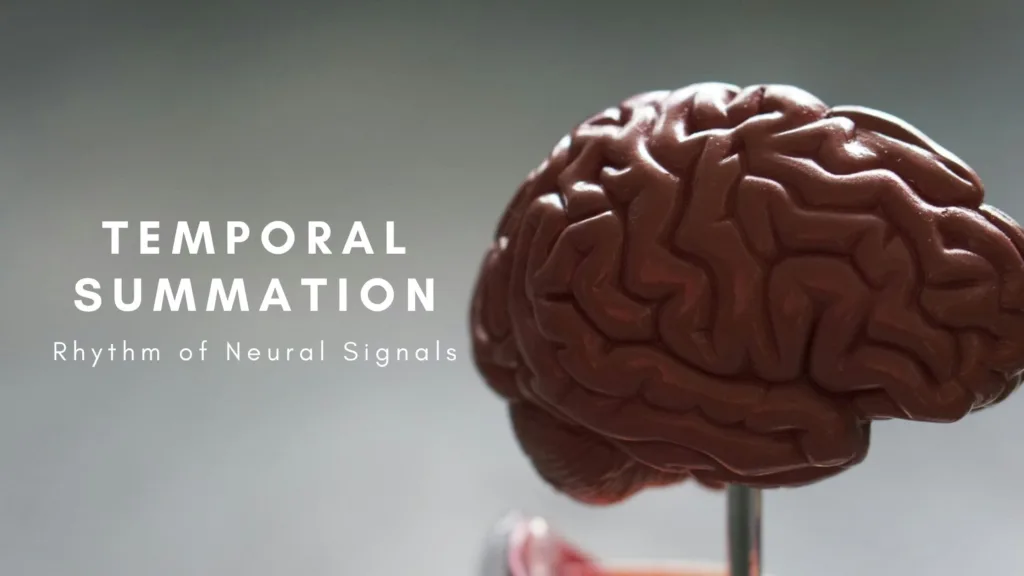Temporal summation is an important idea in neuroscience that explains how quickly repeated signals at one synapse can add up to create a stronger response in the next neuron. This process is crucial for how the brain combines sensory information, creates neural signals, and works overall.
Understanding Temporal Summation
Temporal summation is a process in the brain where signals that arrive quickly one after another at the same spot add up to create a stronger response in the receiving neuron. Imagine tapping your finger on a table repeatedly; each tap is like a signal. If you tap slowly, each tap is separate, but if you tap quickly, the vibrations add up to a stronger feeling.
Similarly, in the brain, if a neuron receives signals rapidly from another neuron, the combined effect can trigger a bigger response, like making a muscle move or processing a sound. For example, if you’re touching something hot, the quick, repeated signals sent to your brain help you quickly feel the heat and react by pulling your hand away.
What is Synaptic Transmission?
To understand temporal summation, it’s important to first know how neurons talk to each other. Neurons are nerve cells that send messages through special connections called synapses. At a synapse, the end part of one neuron (called the axon terminal) is very close to a part of another neuron (called the dendrite). When a neuron sends a message, it creates an electrical signal known as an action potential.
This action potential travels to the axon terminal and causes the release of chemicals called neurotransmitters into the small gap between the two neurons, known as the synaptic cleft. These neurotransmitters then attach to special spots on the receiving neuron (called receptors). When the neurotransmitters bind to these receptors, they cause small channels in the neuron to open, allowing ions (tiny charged particles) to flow in or out.
This flow of ions changes the electrical charge inside the receiving neuron, creating what is called a postsynaptic potential. This change can either make the neuron more likely to send its own signal or less likely, depending on the type of neurotransmitter and receptor involved.

Types of Postsynaptic potentials:
There are two main types of changes in a neuron’s charge when it receives a signal:
- Excitatory Postsynaptic Potentials (EPSPs):
- What They Do: EPSPs make the inside of the neuron more positive.Effect: This makes it more likely that the neuron will send its own signal.
- Example: When a chemical messenger like glutamate attaches to the neuron, it opens channels that let positive particles in, making the neuron ready to send a signal.
- Inhibitory Postsynaptic Potentials (IPSPs):
- What They Do: IPSPs make the inside of the neuron more negative.Effect: This makes it less likely that the neuron will send a signal.
- Example: When a chemical messenger like GABA attaches to the neuron, it opens channels that let negative particles in or positive particles out, making the neuron less ready to send a signal.
Factors on which Temporal Summation Depends
· Frequency of Stimuli:
- Higher frequencies increase the likelihood of overlapping and summing effects.
· Time Constant of the Postsynaptic Neuron:
- Longer time constants allow effects to last longer, enhancing summation.
· Amplitude of Each Postsynaptic Potential:
- Stronger potentials contribute more to reaching the action potential threshold.
· Distance from Synapse to Axon Hillock:
- Closer signals are less likely to decay before reaching the axon hillock.
· Type and State of Ion Channels:
- Different ion channels and their states affect the strength and duration of potentials.
· Synaptic Plasticity:
Repeated stimulation can alter synaptic strength, affecting summation over time.
Temporal Summation vs. Spatial Summation
Temporal summation is like stacking blocks over time, where each block represents a signal arriving at a single spot on a neuron. The more blocks (signals) stack up quickly, the higher the chance of triggering the neuron to fire. Spatial summation, on the other hand, is like combining blocks from different places at the same time. It’s about adding up signals from different spots on the neuron all at once to make it more likely to fire. So, temporal summation is about stacking signals over time, while spatial summation is about combining signals from different places all at once. Both help the neuron decide when to send its own signal.
Importance of Temporal Summation
Here’s a simplified version of the importance of temporal summation:
- Putting Signals Together: Temporal summation helps neurons mix up lots of signals arriving at once. This helps them notice patterns or changes in information.
- Making Signals Stronger: It’s like turning up the volume on a quiet sound. Temporal summation can make weak signals stronger so they can trigger the neuron to send its own signal.
- Helping Us Sense the World: Temporal summation is like a superpower for our senses. It lets us detect fast changes in things like light, sound, or touch, helping us react quickly.
- Controlling Our Movements: Think of it as the conductor of an orchestra. Temporal summation coordinates signals from different sources to make our movements smooth and precise.
- Remembering and Learning: It’s like building a stronger bridge between neurons. Temporal summation helps strengthen connections in our brain, which is important for learning new things and remembering them later.
- Understanding Disorders: When temporal summation goes haywire, it can cause problems like chronic pain or epilepsy. Figuring out how it changes in these conditions can help doctors find better treatments.
Temporal summation is like a superhero power for neurons. It’s how they mix and react to lots of signals coming in at once. This helps our brain deal with fast-changing stuff around us, like seeing, moving, and thinking. Understanding how it works helps scientists and doctors tackle brain problems better.
